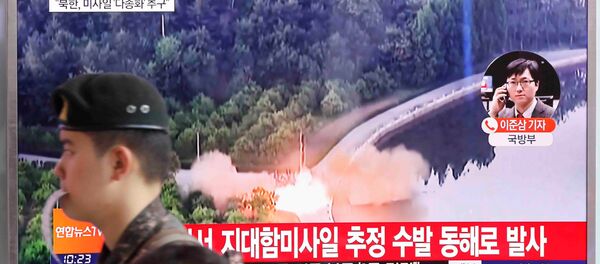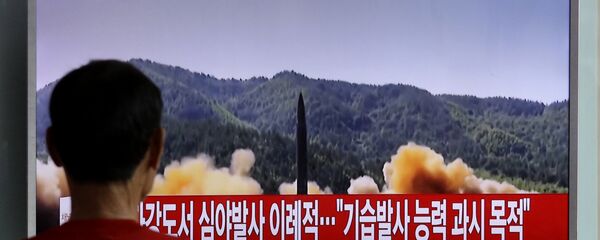According to North Korea's KCNA state news agency, leader Kim Jong-un himself oversaw the launches, but didn't specify the weapons fired.
KCNA also quoted Kim as saying that "genuine peace and security of the country are guaranteed only by the strong physical force capable of defending its sovereignty."
Kim Dong-yup, professor at the Institute for Far East Studies of Kyungnam University, told Sputnik that North Korea might have launched Scud C and Scud B missiles, though he later expressed his doubts.
"If we only look on the range, then 420 km — this may be Scud C, and 270 km — Scud B. But considering that both had an altitude of 50 km, it is rather doubtful that Scuds would be launched at a low angle. In addition, the launch site was in Kusong, where previously, new types of missiles, such as Musudan or Pukkykson, were usually tested. It would be strange if they began to transport the old Scuds to Kusong and launch them from there. Moreover, Scud is a short-range ballistic missile, and this would be a violation of UN sanctions."
READ MORE: Trump Welcomes Statements Made by Putin About North Korea
The professor believes that Pyongyang, technically, didn't violate its self-imposed moratorium with these weapons tests.
"North Korea, of course, stated that it would not look at the sanctions, and, when it announced a moratorium on missile launches, spoke only of medium and long-range missiles and not short-range ones, therefore, it [can] say that it didn't violate the terms of talks by launching Scud. However, the 50 km height suggests that this was a military launch of tactical guided weapons — the North Korean Iskander, that was also recently launched from the Hodo Peninsula, Kim Dong-yup said.
He went on to note that "after Kim Jong-un supervised its development, in November last year and this April, the rocket was launched and flew 240 km from Hodo [on the coast of the Sea of Japan]. And now from the inside of the country, in order to demonstrate the stability and reliability of the new weapon."
READ MORE: Kim Asked Putin to Convey N.Korea's Denuclearisation Stance to China, US — Intel
The latest launches were the country's first since November 2017, when North Korea last tested a ballistic missile. The Kyungnam University professor believes the latest launches are due to Kim Jong-un being discontent with the current state of affairs, but that's not the only reason.
"First of all, it is a signal not to try to entice or to get Pyongyang to reconsider its position with food aid. It seems that the North Koreans make it clear that they will not make concessions and will not surrender, so the partners need to change their expectations," Kim Dong-yup shared his point of view.
Meanwhile, Cheong Seong-Chang, vice president of Research Planning at the Sejong Institute, told Sputnik that several factors played a role here, including Kim's frustration with the recent joint US-South Korean military exercises, the failure of the US-North Korea summit in Hanoi, and the fact that South Korea called the 4 May missile launch a provocation.
"It seems that with the help of the current missile tests, Pyongyang wants to demonstrate to the world capabilities of its missiles, which even THAAD cannot intercept, and also reassure the country's military who are dissatisfied with the denuclearization talks.
In addition, North Korea's latest launches, apparently, are aimed at negotiating a suspension of the joint US-South Korean military exercises, which Pyongyang considers a threat, during the inter-Korean and US-North Korean dialogue. And North Korea's future strategy will be to raise questions about ensuring its security," Cheong Seong-Chang said.
The expert noted that unless the situation changes, short-range missile tests are likely to continue.
"Under these conditions, in order to stop North Korea's wrong assertions and avoid misinterpretations in South Korea and the United States, Seoul needs to postpone the delivery of humanitarian aid to Pyongyang until the security situation is improved. And also to stabilise this situation as soon as possible by completing, in the near future, a comprehensive plan of action on denuclearization and reciprocal measures, that both the United States and North Korea will be ready to accept, so that Pyongyang can return to denuclearisation talks," Cheong Seong-Chang concluded.
In February, US President Donald Trump and Kim Jong-un met in Vietnam to try to negotiate a deal on ending North Korea's nuclear and missile programmes, but the talks stalled as the sides failed to accept each others demands or make concessions.
Views and opinions expressed in this article are those of the speakers and do not necessarily reflect those of Sputnik.





